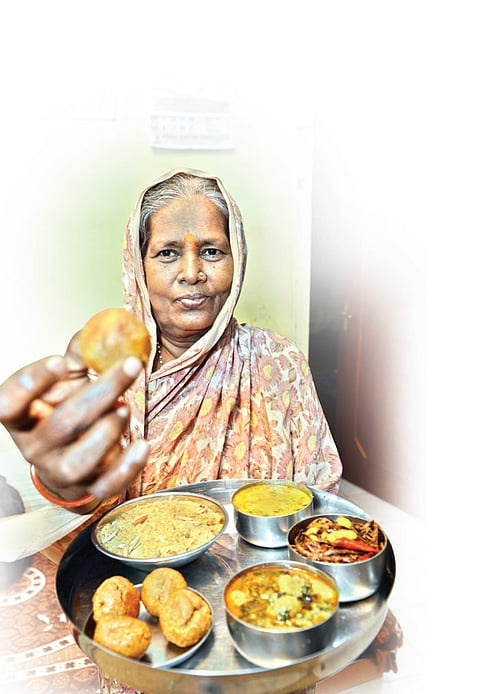

Royal is the word that comes to your mind when you think of Rajasthan. Not because of the IPL cricket team, but because it is a land of royal families and cuisine. The cuisine prepared by middle class families is also ‘royal’ in its own way. If you love spicy food with lots of ghee in it, Rajasthani cuisine is worth more than just a try. Ghee is something that defines Rajasthani cuisine as it is known for its richness.
Sundari Bai, a Marwari from Rajasthan is settled in Chennai for over 40 years and is a renowned caterer. A much sought-after caterer, she has been to cities like Bangalore, Hubli, Delhi, and Kolkata, where she has dished out the Rajasthani platter for weddings, festivals, birthdays and other functions.
She takes this reporter into the delectable and eclectic Rajasthani cuisine.
Dal-bati-churma is the signature combination of Rajasthan. The dal is a mixture of five types of pulses, fried in a specific home-made masala (paste), a common ingredient used in other food items like gatte ki sabji (a dish made from gram seed flour dough).
The typical aromatic masala is a perfect blend of tomatoes, onions, garlic, coriander, cumin, cloves, cardamom, cashew (for some dishes), black pepper seeds and so on. These are a few ingredients that are common for most Rajasthani dishes. However, some ingredients vary with the dish.
Rajasthanis prepare bati in two ways — in one the batis (balls made from wheat flour with or without a special filling) are fried in oil after being boiled in water for several minutes. This is crisp from outside and soft within. The other way is to bake the batis on coal fire.
The churma is made by frying aata (wheat flour), besan (gram seed flour) and sooji in ghee with very little water. It looks like a powder, but is soft and crispy at the same time.
Another dish is kher sangri, made from the vegetable by the same name that is available only in Rajasthan and some parts in the North.
Rajasthanis settled in Chennai bring it from their village to make the preparation.
It is used for making a regular sabji where it is fried in the same masala with cashew and raisins or a pickle. The sabji tastes quite different from other similar vegetables like beans.
After having Rajasthani cuisine you might feel heavy because of the richness in taste and aroma.
But the food will definitely charge you gustatory senses, tempting you to have it again, even if you are a health-conscious person.
She recalls travelling across the country. With pride she says, “Maine sara desh ghuma hain bas London hi baki hai (I have seen the whole of India, only London if left).”
Touching the lives of many through food is what septuagenarian Sundari Bai follows.
After losing her husband and her son-in-law, she took care of her daughter and her children with the money she earns through her catering service.
She says, “I can make everything (North Indian dishes as well as South Indian) including samosa, pani puri, bhel puri and of course the authentic Rajasthani that I have made a name out of.”
Her daughter does a similar business in Hyderabad and her children Tej Karan and Aarti claim that their mother can make Chinese and other Continental cuisine as well, which their grandmother can’t make.
Sundari Bai supervises the whole thing with the help of some assistants, but at home she cooks herself with help from her grandson’s wife Tara, who also has good culinary skills like her mother-in-law and her mother.
She and her family members say that some of their relatives who are also settled in Chennai are in this business, adding that even South Indians love and order authentic Rajasthani cuisine.